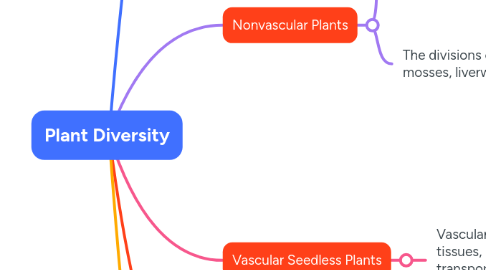
1. What is a plant?
1.1. A plant is a living thing that grows in the Earth and has a stem, leaves, and roots.
1.1.1. Roots absord water and minerals from the soil,which plants require for cellular processes.
1.1.1.1. Some roots store food such as sugar and starch.
1.1.2. Stems help support the leaves, and in some cases flowers, of a plant.
1.1.2.1. Stems have tissues that help carry water and minerals absorbed by the roots to a plant's leaves
1.1.3. Leaves in most plants, leaves are the major sites for photosyntesis
1.1.3.1. In addition to making food, leaves also are involved in the exchange of gases with the environment.
1.2. Plant Cells
1.2.1. Did you know that your cells and animal cells are similar to plant cells?
1.2.1.1. They have mave many of the same organelles such as
1.2.1.1.1. A nucleus
1.2.1.1.2. Mitochondria
1.2.1.1.3. Ribosomes
2. Nonvascular Plants
2.1. Plant that lack specialized tissues for transporting water and nutrients are called nonvascular plants.
2.2. The divisions of nonvascular plants include mosses, liverworts, and hornworts.
2.2.1. One type of plant that lack specialized transport tissues is mosses.
2.2.1.1. An rootlike structure called rhizoids help anchor a moss and absorb water.
2.2.1.1.1. Rhizoids are structures that anchoir a plant with transport tissue to a surface.
2.2.2. There are two types of liverworts
2.2.2.1. The tallose form is flat and lobed
2.2.2.2. A leafy liverwort has small, leaflike structures attached to a central stalk
2.2.3. Hornworts appear similar to liverworts.However, a hornwort's reproductive structure resembles a small horn.
3. Vascular Seedless Plants
3.1. Vascular plants have specialized tissues, called vascular tissues, that transports water and nutrients throughout the plant.
4. Vascular plants are divided into two groups those that produce seeds and those that do not.
4.1. Ferns, horsetails, and club mosses do not produce seeds
4.1.1. Fossil evidence indicates that million of years ago ferns grew as large as trees.
4.1.2. Horsetails get their name from stage of their life cycle that looks like an horse's tails.
4.1.2.1. Horsetails also are called scouring rushes due to an abrassive mineral called silica in the stems.
4.1.2.1.1. This abrasiveness made the horsetail plant useful to early settlers and campers for cleaning pots and pans.
4.1.3. Club mosses, this group of plants gets its name from its reproductive structure that resembles a club.
4.1.3.1. These plants were abundant to ancient forests.
4.1.3.1.1. Much of the fossil fuels we use today come from those ancient forests.
5. Vascular Seed Plants
5.1. Probably most of the plants you are familiar with are vascular seed plants.
5.1.1. Nonflowering Seed Plants
5.1.1.1. For many plants, seeds are inside or on the surface of fruits.However, some plants produce seeds without fruits.
5.1.1.1.1. Gymnosperms are plants that produce seeds that are not part of a fruit.
5.1.2. Flowering Seed Plants
5.1.2.1. There are more than 260,000 species of flowering plants
5.1.2.1.1. Angiosperms are plants that produce flowers and develop fruits.
5.1.2.1.2. Flowering plants have many adaptation that enable them to survive in most habitats on Earth.
